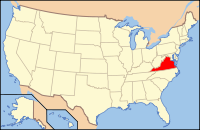Wythe County, Virginia
| Wythe County, Virginia | ||
|---|---|---|

Wythe County Courthouse in Wytheville
|
||
|
||
 Location in the U.S. state of Virginia |
||
 Virginia's location in the U.S. |
||
| Founded | 1790 | |
| Named for | George Wythe | |
| Seat | Wytheville | |
| Largest town | Wytheville | |
| Area | ||
| • Total | 465 sq mi (1,204 km2) | |
| • Land | 462 sq mi (1,197 km2) | |
| • Water | 2.8 sq mi (7 km2), 0.6% | |
| Population (est.) | ||
| • (2015) | 29,119 | |
| • Density | 63/sq mi (24/km²) | |
| Congressional district | 9th | |
| Time zone | Eastern: UTC-5/-4 | |
| Website | www |
|
Wythe County is a county located in the U.S. state of Virginia. As of the 2010 census, the population was 29,235. Its county seat is Wytheville.
Wythe County was formed from Montgomery County in 1790. It was named after George Wythe, the first Virginian signer of the Declaration of Independence. During the Civil War the Battle of Cove Mountain was fought in the county.
Prior to Wythe County's creation, what is now the Wythe County community of Austinville served as the county seat for Fincastle County, an extinct Virginia county whose borders stretched from Roanoke, Virginia, to the Mississippi River – a county roughly the size of half the State of Texas.
Wythe County's Austinville community, which was founded by Stephen and his brother Moses Austin, father of the famous Stephen F. Austin. In the 1790s the Austins took over the mines that produced lead and zinc; the town was named for the Austin surname, and not for any one particular Austin of the brothers who bore that surname. Lead was mined and shipped throughout the fledgling country; lead shot was also produced. Located near Fosters Falls, Jackson Ferry Shot Tower still stands as a testament to the citizens of Wythe County. Lead was hoisted to the top of the tower using block and tackle and oxen. The lead was melted in a retort and then poured through a sieve at the top of the tower. The droplets of molten lead would become round during the 150-foot descent. The shot would collect in a kettle of water and slave laborers would enter through a 110-foot access tunnel located near the bank of the New River to retrieve the shot from the kettle.
...
Wikipedia

